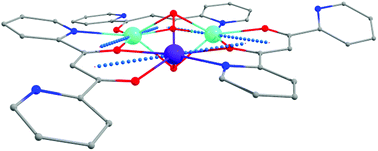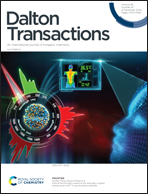Lanthanoid pyridyl-β-diketonate ‘triangles’. New examples of single molecule toroics†
Abstract
Trinuclear lanthanoid clusters have been synthesised and investigated as toroidal spin systems. A pyridyl functionalised β-diketonate, 1,3-bis(pyridin-2-yl)propane-1,3-dione (o-dppdH) has been used to synthesise a family of clusters of the form [Dy3(OH)2(o-dppd)3Cl2(H2O)4]Cl2·7H2O (1), [Tb3(o-dppd)3(μ3-OH)2(CH3CH2OH)3Cl3][Tb3(o-dppd)3(μ3-OH)2(H2O)(CH3CH2OH)2Cl3]Cl2·H2O (2), [Ho3(OH)2(o-dppd)3Cl(H2O)5]Cl3·3H2O (3) and [Er3(OH)2(o-dppd)3Cl2(H2O)3(CH3OH)]Cl2·3H2O·CH3OH (4). Despite the previous occurrence of this structural motif in the literature, these systems have not been widely investigated in terms of torodic behaviour. Magnetic studies were used to further characterise the complexes. DC susceptibility studies support weak antiferromagnetic exchange in the complexes. Slow magnetic relaxation behaviour is observed in the dynamic AC magnetic studies for complex 1. Theoretical studies predict that complex 1 and 3 have a non-magnetic ground state based on a toroidal arrangement of spins. Changes to the coordination environment in 2 do not support a toroic spin state. The prolate nature of the ErIII centres in complex 4 and large transverse anisotropy do not support the toroidal arrangement of lanthanoid spins in the complex.



 Please wait while we load your content...
Please wait while we load your content...